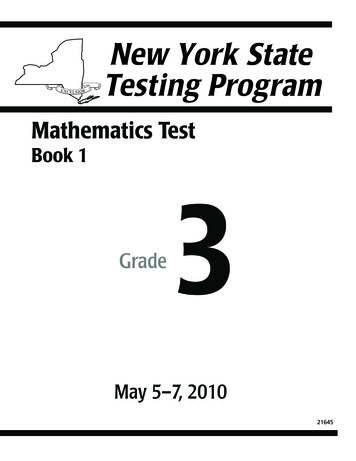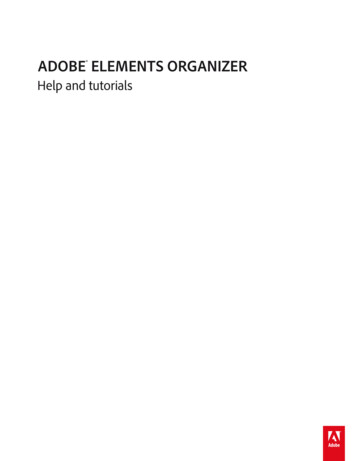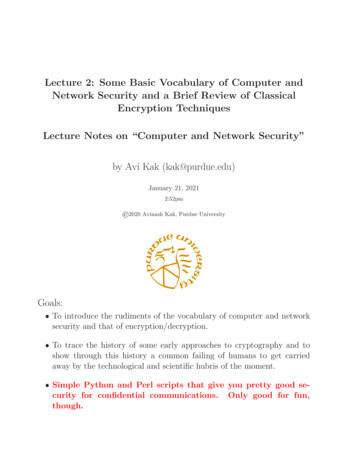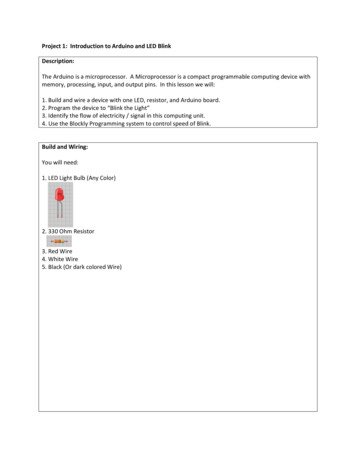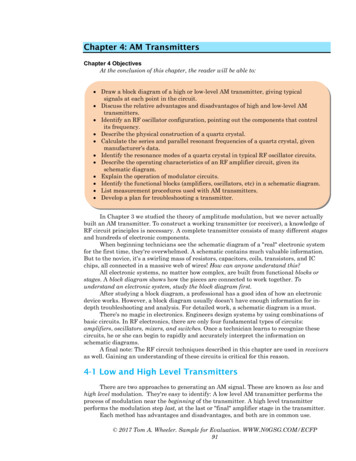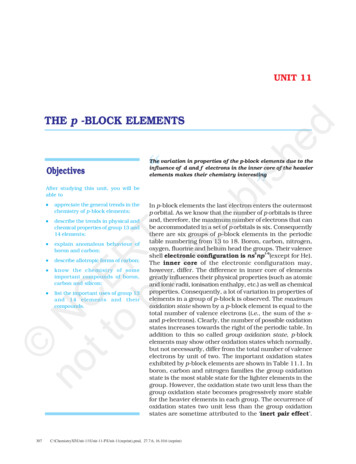
Transcription
THE p-BLOCK ELEMENTS307UNIT 11hedTHE p -BLOCK ELEMENTSAfter studying this unit, you will beable toappreciate the general trends in thechemistry of p-block elements;In p-block elements the last electron enters the outermostp orbital. As we know that the number of p orbitals is threeand, therefore, the maximum number of electrons that canbe accommodated in a set of p orbitals is six. Consequentlythere are six groups of p–block elements in the periodictable numbering from 13 to 18. Boron, carbon, nitrogen,oxygen, fluorine and helium head the groups. Their valence21-6shell electronic configuration is ns np (except for He).The inner core of the electronic configuration may,however, differ. The difference in inner core of elementsgreatly influences their physical properties (such as atomicand ionic radii, ionisation enthalpy, etc.) as well as chemicalproperties. Consequently, a lot of variation in properties ofelements in a group of p-block is observed. The maximumoxidation state shown by a p-block element is equal to thetotal number of valence electrons (i.e., the sum of the sand p-electrons). Clearly, the number of possible oxidationstates increases towards the right of the periodic table. Inaddition to this so called group oxidation state, p-blockelements may show other oxidation states which normally,but not necessarily, differ from the total number of valenceelectrons by unit of two. The important oxidation statesexhibited by p-block elements are shown in Table 11.1. Inboron, carbon and nitrogen families the group oxidationstate is the most stable state for the lighter elements in thegroup. However, the oxidation state two unit less than thegroup oxidation state becomes progressively more stablefor the heavier elements in each group. The occurrence ofoxidation states two unit less than the group oxidationstates are sometime attributed to the ‘inert pair effect’. no NCtt Eo Rbe Trepu blisThe variation in properties of the p-block elements due to theinfluence of d and f electrons in the inner core of the heavierelements makes their chemistry interesting307307 describe the trends in physical andchemical properties of group 13 and14 elements; explain anomalous behaviour ofboron and carbon; describe allotropic forms of carbon; know the chemistry of someimportant compounds of boron,carbon and silicon; list the important uses of group 13and 14 elements and (reprint)
308CHEMISTRYTable 11.1 General Electronic Configuration and Oxidation States of p-Block ns2np2ns2np3ns2np4ns2np5ns2np6(1s2 for He)First memberof thegroupBCNOFHeGroupoxidationstate 3 4 5 6 7 8Otheroxidationstates 1 2, – 4 3, – 3 4, 2, –2 5, 3, 1, –1 6, 4, 217It is interesting to note that the non-metalsand metalloids exist only in the p-block of theperiodic table. The non-metallic character ofelements decreases down the group. In fact theheaviest element in each p-block group is themost metallic in nature. This change from nonmetallic to metallic character brings diversityin the chemistry of these elements dependingon the group to which they belong.In general, non-metals have higher ionisationenthalpies and higher electronegativities thanthe metals. Hence, in contrast to metals whichreadily form cations, non-metals readily formanions. The compounds formed by highlyreactive non-metals with highly reactive metalsare generally ionic because of large differencesin their electronegativities. On the other hand,compounds formed between non-metalsthemselves are largely covalent in characterbecause of small differences in theirelectronegativities. The change of non-metallicto metallic character can be best illustrated bythe nature of oxides they form. The non-metaloxides are acidic or neutral whereas metaloxides are basic in nature.30830818heisblThe first member of p-block differs from theremaining members of their correspondinggroup in two major respects. First is the sizeand all other properties which depend on size.Thus, the lightest p-block elements show thesame kind of differences as the lightest s-blockelements, lithium and beryllium. The secondimportant difference, which applies only to thep-block elements, arises from the effect of dorbitals in the valence shell of heavier elements(starting from the third period onwards) andtheir lack in second period elements. Thesecond period elements of p-groups startingfrom boron are restricted to a maximumcovalence of four (using 2s and three 2porbitals). In contrast, the third period elementsof p-groups with the electronic configurationn3s23p have the vacant 3d orbitals lyingbetween the 3p and the 4s levels of energy.Using these d-orbitals the third periodelements can expand their covalence abovefour. For example, while boron forms only–3–[BF 4] , aluminium gives [AlF 6] ion. Thepresence of these d-orbitals influences thechemistry of the heavier elements in a numberof other ways. The combined effect of size andavailability of d orbitals considerablyinfluences the ability of these elements to formπ bonds. The first member of a group differsfrom the heavier members in its ability to formpπ - pπ multiple bonds to itself ( e.g., C C, C C, no NCtt Eo Rbe TrepuThe relative stabilities of these two oxidationstates – group oxidation state and two unit lessthan the group oxidation state – may vary fromgroup to group and will be discussed atappropriate (reprint)
THE p-BLOCK ELEMENTSdheis11.1.2 Atomic RadiiOn moving down the group, for each successivemember one extra shell of electrons is addedand, therefore, atomic radius is expected toincrease. However, a deviation can be seen.Atomic radius of Ga is less than that of Al. Thiscan be understood from the variation in theinner core of the electronic configuration. Thepresence of additional 10 d-electrons offeronly poor screening effect (Unit 2) for the outerelectrons from the increased nuclear charge ingallium. Consequently, the atomic radius ofgallium (135 pm) is less than that ofaluminium (143 pm). no NCtt Eo Rbe Trepu11.1 GROUP 13 ELEMENTS: THE BORONFAMILY11.1.1 Electronic ConfigurationThe outer electronic configuration of these21elements is ns np . A close look at theelectronic configuration suggests that whileboron and aluminium have noble gascore, gallium and indium have noble gas plus10 d-electrons, and thallium has noble gasplus 14 f- electrons plus 10 d-electron cores.Thus, the electronic structures of theseelements are more complex than for the firsttwo groups of elements discussed in unit 10.This difference in electronic structures affectsthe other properties and consequently thechemistry of all the elements of this group.blN N) and to other second row elements (e.g.,C O, C N, C N, N O). This type of π - bondingis not particularly strong for the heavierp-block elements. The heavier elements do formπ bonds but this involves d orbitals (dπ – pπor dπ –dπ ). As the d orbitals are of higherenergy than the p orbitals, they contribute lessto the overall stability of molecules than doespπ - pπ bonding of the second row elements.However, the coordination number in speciesof heavier elements may be higher than forthe first element in the same oxidation state.For example, in 5 oxidation state both N and–P form oxoanions : NO3 (three-coordinationwith π – bond involving one nitrogen p-orbital)and PO34 (four-coordination involving s, p andd orbitals contributing to the π – bond). Inthis unit we will study the chemistry of group13 and 14 elements of the periodic table.309This group elements show a wide variation inproperties. Boron is a typical non-metal,aluminium is a metal but shows manychemical similarities to boron, and gallium,indium and thallium are almost exclusivelymetallic in character.Boron is a fairly rare element, mainlyoccurs as orthoboric acid, (H3BO3), borax,Na2B4O7·10H2O, and kernite, Na2B4O7·4H2O.In India borax occurs in Puga Valley (Ladakh)and Sambhar Lake (Rajasthan). Theabundance of boron in earth crust is less than0.0001% by mass. There are two isotopic1011forms of boron B (19%) and B (81%).Aluminium is the most abundant metal andthe third most abundant element in the earth’scrust (8.3% by mass) after oxygen (45.5%) andSi (27.7%). Bauxite, Al2O3. 2H2O and cryolite,Na 3 AlF 6 are the important minerals ofaluminium. In India it is found as mica inMadhya Pradesh, Karnataka, Orissa andJammu. Gallium, indium and thallium are lessabundant elements in nature.The atomic, physical and chemicalproperties of these elements are discussedbelow.30930911.1.3 Ionization EnthalpyThe ionisation enthalpy values as expectedfrom the general trends do not decreasesmoothly down the group. The decrease fromB to Al is associated with increase in size. Theobserved discontinuity in the ionisationenthalpy values between Al and Ga, andbetween In and Tl are due to inability of d- andf-electrons ,which have low screening effect, tocompensate the increase in nuclear charge.The order of ionisation enthalpies, asexpected, is Δi H1 Δi H2 Δi H3. The sum of thefirst three ionisation enthalpies for each of theelements is very high. Effect of this will beapparent when you study their chemicalproperties.11.1.4 ElectronegativityDown the group, electronegativity firstdecreases from B to Al and then -11(reprint).pmd, Reprint27.7.6, 16.10.627.7.6 (reprint)
310CHEMISTRYonly covalent compounds. But as we move fromB to Al, the sum of the first three ionisationenthalpies of Al considerably decreases, and3 is therefore able to form Al ions. In fact,aluminium is a highly electropositive metal.However, down the group, due to poorshielding effect of intervening d and f orbitals,the increased effective nuclear charge holds nselectrons tightly (responsible for inert paireffect) and thereby, restricting theirparticipation in bonding. As a result of this,only p-orbital electron may be involved inbonding. In fact in Ga, In and Tl, both 1 and 3 oxidation states are observed. The relativestability of 1 oxidation state progressivelyincreases for heavier elements: Al Ga In Tl. Inthallium 1 oxidation state is predominantwhereas the 3 oxidation state is highlyoxidising in character. The compounds in 1 oxidation state, as expected from energyconsiderations, are more ionic than those in 3 oxidation state.In trivalent state, the number of electronsaround the central atom in a moleculemarginally (Table 11.2). This is because of thediscrepancies in atomic size of the elements.ished11.1.5 Physical PropertiesBoron is non-metallic in nature. It is extremelyhard and black coloured solid. It exists in manyallotropic forms. Due to very strong crystallinelattice, boron has unusually high melting point.Rest of the members are soft metals with lowmelting point and high electrical conductivity.It is worthwhile to note that gallium withunusually low melting point (303 K), couldexist in liquid state during summer. Its highboiling point (2676 K) makes it a usefulmaterial for measuring high temperatures.Density of the elements increases down thegroup from boron to thallium.bl11.1.6 Chemical Properties no NCtt Eo Rbe TrepuOxidation state and trends in chemicalreactivityDue to small size of boron, the sum of its firstthree ionization enthalpies is very high. Thisprevents it to form 3 ions and forces it to formTable 11.2 Atomic and Physical Properties of Group 13 ElementsPropertyBoronBAtomic numberAluminiumAl513Atomic mass(g mol )10.8126.98Electronic Configuration[He]2s22p1[Ne]3s23p1–1Atomic 145d106s26p1(88)143135167170Ionic radiusM3 /pmb(27)53.562.080.088.5Ionic radiusM 1820270458919712877Ionizationenthalpy(kJ mol–1)Δi H 1Δi H 2Δi H 3aElectronegativityc2.01.51.61.71.8Density /g cm–3at 298 K2.352.705.907.3111.85Melting point / K2453933303430576Boiling point / K39232740267623531730–1.66–0.56–0.34 1.26-0.79(acid)–1.39(alkali)–0.18–0.34V3 -V -E / V for (M /M)E / V for (M /M)aMetallic radius,310b 0.55c6-coordination, Pauling scale,27.7.6, print).pmd, Reprint27.7.6 (reprint)
THE p-BLOCK ELEMENTSsolution but is a powerful oxidising agent also. Thus Tl is more stable in solution3 than Tl . Aluminium being able to form 3 ions easily, is more electropositive thanthallium.d(i) Reactivity towards airBoron is unreactive in crystalline form.Aluminium forms a very thin oxide layer onthe surface which protects the metal fromfurther attack. Amorphous boron andaluminium metal on heating in air form B2O3and Al2O3 respectively. With dinitrogen at hightemperature they form nitrides.heof the compounds of these elements(e.g., boron in BF3) will be only six. Suchelectron deficient molecules have tendencyto accept a pair of electrons to achieve stableelectronic configuration and thus, behave asLewis acids. The tendency to behave as Lewisacid decreases with the increase in the sizedown the group. BCl3 easily accepts a lone pairof electrons from ammonia to form BCl3 NH3.311Δ2E ( s ) 3O2 ( g ) 2E 2O3 ( s )isAlCl3 achieves stability by forming a dimerΔ2E ( s ) N 2 ( g ) 2EN ( s ) no NCtt Eo Rbe Trepubl(E element)The nature of these oxides varies down thegroup. Boron trioxide is acidic and reacts withbasic (metallic) oxides forming metal borates.Aluminium and gallium oxides are amphotericand those of indium and thallium are basic intheir properties.In trivalent state most of the compoundsbeing covalent are hydrolysed in water. Forexample, the trichlorides on hyrolysis in water form tetrahedral M ( OH )4 species; the3hybridisation state of element M is sp .Aluminium chloride in acidified aqueous3 solution forms octahedral Al ( H2 O )6 ion.In this complex ion, the 3d orbitals of Al areinvolved and the hybridisation state of Al issp3d2.Problem 11.1VStandard electrode potential values, E3 3 for Al /Al is –1.66 V and that of Tl /Tlis 1.26 V. Predict about the formation of3 M ion in solution and compare theelectropositive character of the twometals.SolutionStandard electrode potential values for twohalf cell reactions suggest that aluminium3 has high tendency to make Al (aq) ions,3 whereas Tl is not only unstable int).pmd, Reprint 27.7.6(ii) Reactivity towards acids and alkaliesBoron does not react with acids and alkalieseven at moderate temperature; but aluminiumdissolves in mineral acids and aqueous alkaliesand thus shows amphoteric character.Aluminium dissolves in dilute HCl andliberates dihydrogen.3 –2Al(s) 6HCl (aq) 2Al (aq) 6Cl (aq) 3H2 (g)However, concentrated nitric acid rendersaluminium passive by forming a protectiveoxide layer on the surface.Aluminium also reacts with aqueous alkaliand liberates dihydrogen.2Al (s) 2NaOH(aq) 6H2O(l) –2 Na [Al(OH)4] (aq) 3H2(g)Sodiumtetrahydroxoaluminate(III)(iii) Reactivity towards halogensThese elements react with halogens to formtrihalides (except Tl I3).(X F, Cl, Br, I)2E(s) 3 X2 (g) 2EX3 (s)
312CHEMISTRYSolutionAnhydrous aluminium chloride ispartially hydrolysed with atmosphericmoisture to liberate HCl gas. Moist HClappears white in colour.11.3 SOME IMPORTANT COMPOUNDS OFBORONSome useful compounds of boron are borax,orthoboric acid and diborane. We will brieflystudy their chemistry.11.3.1 BoraxIt is the most important compound of boron.It is a white crystalline solid of formulaNa 2 B 4 O 7 10H 2 O. In fact it contains the2 ishetetranuclear units B4 O5 ( OH )4 and correctformula; therefore, is Na2[B4O5 (OH)4].8H2O.Borax dissolves in water to give an alkalinesolution.blNa2B4O7 7H2O 2NaOH 4H3BO3Orthoboric acidOn heating, borax first loses watermolecules and swells up. On further heating itturns into a transparent liquid, which solidifiesinto glass like material known as boraxbead. no NCtt Eo Rbe Trepu11.2 IMPORTANTTRENDSANDANOMALOUS PROPERTIES OFBORONCertain important trends can be observedin the chemical behaviour of group13 elements. The tri-chlorides, bromidesand iodides of all these elements beingcovalent in nature are hydrolysed in water.–Species like tetrahedral [M(OH) 4] and3 octahedral [M(H2O)6] , except in boron, existin aqueous medium.The monomeric trihalides, being electrondeficient, are strong Lewis acids. Borontrifluoride easily reacts with Lewis bases suchas NH 3 to complete octet aroundboron.F3 B :NH3 F3 B NH3It is due to the absence of d orbitals thatthe maximum covalence of B is 4. Since thed orbitals are available with Al and otherelements, the maximum covalence can beexpected beyond 4. Most of the other metalhalides (e.g., AlCl3) are dimerised throughhalogen bridging (e.g., Al2Cl6). The metalspecies completes its octet by acceptingelectrons from halogen in these halogenbridged molecules.Problem 11.33–Boron is unable to form BF6 ion. Explain.SolutionDue to non-availability of d orbitals, boronis unable to expand its octet. Therefore,the maximum covalence of boron cannotexceed int).pmd, Reprint 27.7.6dProblem 11.2White fumes appear around the bottle ofanhydrous aluminium chloride. Givereason.ΔΔNa2B4O7.10H2O Na2B4O7 2NaBO2Sodiummetaborate B2O3BoricanhydrideThe metaborates of many transition metalshave characteristic colours and, therefore,borax bead test can be used to identify themin the laboratory. For example, when borax isheated in a Bunsen burner flame with CoO ona loop of platinum wire, a blue colouredCo(BO2)2 bead is formed.11.3.2 Orthoboric acidOrthoboric acid, H3BO3 is a white crystallinesolid, with soapy touch. It is sparingly solublein water but highly soluble in hot water. It canbe prepared by acidifying an aqueous solutionof borax.Na2B4O7 2HCl 5H2O 2NaCl 4B(OH)3It is also formed by the hydrolysis (reactionwith water or dilute acid) of most boroncompounds (halides, hydrides, etc.). It has alayer structure in which planar BO3 units are
THE p-BLOCK ELEMENTSB2 H6 3O2 B2 O3 3H2 O;Δc HV 1976 kJ mol 1Most of the higher boranes are alsospontaneously flammable in air. Boranes arereadily hydrolysed by water to give boric acid.B2H6(g) 6H2O(l) 2B(OH)3(aq) 6H2(g)Diborane undergoes cleavage reactionswith Lewis bases(L) to give borane adducts,BH3 LB2H6 2 NMe3 2BH3 NMe3B2H6 2 CO 2BH3 COReaction of ammonia with diborane givesinitially B2H6.2NH3 which is formulated as –[BH2(NH3)2] [BH4] ; further heating givesborazine, B 3 N 3 H 6 known as “inorganicbenzene” in view of its ring structure withalternate BH and NH groups. no NCtt Eo Rbe TrepublisH3BO3 Δ HBO2 Δ B2O3450K2BF3 6NaH B2 H6 6NaFDiborane is a colourless, highly toxic gaswith a b.p. of 180 K. Diborane catches firespontaneously upon exposure to air. It burnsin oxygen releasing an enormous amount ofenergy.dBoric acid is a weak monobasic acid. It isnot a protonic acid but acts as a Lewis acidby accepting electrons from a hydroxylion:– B(OH)3 2HOH [B(OH)4] H3OOn heating, orthoboric acid above 370Kforms metaboric acid, HBO2 which on furtherheating yields boric oxide, B2O3.2NaBH4 I2 B2H6 2NaI H2Diborane is produced on an industrial scaleby the reaction of BF3 with sodium hydride.hejoined by hydrogen bonds as shown inFig. 11.1.313Fig. 11. 1 Structure of boric acid; the dotted linesrepresent hydrogen bondsProblem 11.4Why is boric acid considered as a weakacid?Solution Because it is not able to release H ions–on its own. It receives OH ions from watermolecule to complete its octet and in turn releases H ions.11.3.3 Diborane, B2H6The simplest boron hydride known, isdiborane. It is prepared by treating borontrifluoride with LiAlH4 in diethyl ether.4BF3 3 LiAlH4 2B2H6 3LiF 3AlF3A convenient laboratory method for thepreparation of diborane involves the oxidationof sodium borohydride with (reprint).pmd, Reprint 27.7.6–3B2 H6 6NH3 3[BH2 (NH3 )2 ] [BH4 ]Heat 2B3 N3 H6 12H2The structure of diborane is shown inFig.11.2(a). The four terminal hydrogen atomsand the two boron atoms lie in one plane.Above and below this plane, there are twobridging hydrogen atoms. The four terminalB-H bonds are regular two centre-two electronbonds while the two bridge (B-H-B) bonds aredifferent and can be described in terms of threeFig.11.2(a) The structure of diborane, B2H6
314CHEMISTRYdorthoboric acid is generally used as a mildantiseptic.Aluminium is a bright silvery-white metal,with high tensile strength. It has a highelectrical and thermal conductivity. On aweight-to-weight basis, the electricalconductivity of aluminium is twice that ofcopper. Aluminium is used extensively inindustry and every day life. It forms alloyswith Cu, Mn, Mg, Si and Zn. Aluminium andits alloys can be given shapes of pipe, tubes,rods, wires, plates or foils and, therefore, finduses in packing, utensil making,construction, aeroplane and transportationindustry. The use of aluminium and itscompounds for domestic purposes is nowreduced considerably because of their toxicnature.bl11.5 GROUP 14 ELEMENTS: THE CARBONFAMILY no NCtt Eo Rbe TrepuFig.11.2(b) Bonding in diborane. Each B atomuses sp3 hybrids for bonding. Outof the four sp3 hybrids on each Batom, one is without an electronshown in broken lines. The terminalB-H bonds are normal 2-centre-2electron bonds but the two bridgebonds are 3-centre-2-electron bonds.The 3-centre-2-electron bridge bondsare also referred to as banana bonds.ishecentre–two electron bonds shown inFig.11.2 (b).Boron also forms a series of hydridoborates;–the most important one is the tetrahedral [BH4]ion. Tetrahydridoborates of several metals areknown. Lithium and sodium tetrahydridoborates, also known as borohydrides,are prepared by the reaction of metal hydrideswith B2H6 in diethyl ether. –(M Li or Na)2MH B2H6 2 M [BH4]Both LiBH 4 and NaBH 4 are used asreducing agents in organic synthesis. They areuseful starting materials for preparing othermetal borohydrides.11.4 USES OF BORON AND ALUMINIUMAND THEIR COMPOUNDSBoron being extremely hard refractory solid ofhigh melting point, low density and very lowelectrical conductivity, finds manyapplications. Boron fibres are used in makingbullet-proof vest and light composite material10for aircraft. The boron-10 ( B) isotope has highability to absorb neutrons and, therefore,metal borides are used in nuclear industry asprotective shields and control rods. The mainindustrial application of borax and boric acidis in the manufacture of heat resistant glasses(e.g., Pyrex), glass-wool and fibreglass. Boraxis also used as a flux for soldering metals, forheat, scratch and stain resistant glazed coatingto earthenwares and as constituent ofmedicinal soaps. An aqueous solution int).pmd, Reprint 27.7.6Carbon (C), silicon (Si), germanium (Ge), tin (Sn)and lead (Pb) are the members of group 14.Carbon is the seventeenth most abundantelement by mass in the earth’s crust. It iswidely distributed in nature in free as well asin the combined state. In elemental state it isavailable as coal, graphite and diamond;however, in combined state it is present asmetal carbonates, hydrocarbons and carbondioxide gas (0.03%) in air. One canemphatically say that carbon is the mostversatile element in the world. Its combinationwith other elements such as dihydrogen,dioxygen, chlorine and sulphur provides anastonishing array of materials ranging fromliving tissues to drugs and plastics. Organicchemistry is devoted to carbon containingcompounds. It is an essential constituent ofall living organisms. Naturally occurring12carbon contains two stable isotopes: C and1314C. In addition to these, third isotope, C isalso present. It is a radioactive isotope with halflife 5770 years and used for radiocarbondating. Silicon is the second (27.7 % by mass)most abundant element on the earth’s crustand is present in nature in the form of silicaand silicates. Silicon is a very importantcomponent of ceramics, glass and cement.
THE p-BLOCK ELEMENTS315dhe11.5.4 ElectronegativityDue to small size, the elements of this groupare slightly more electronegative than group13 elements. The electronegativity values forelements from Si to Pb are almost the same.11.5.5 Physical PropertiesAll group 14 members are solids. Carbon andsilicon are non-metals, germanium is a metalloid, no NCtt Eo Rbe Trepu11.5.2 Covalent RadiusThere is a considerable increase in covalentradius from C to Si, thereafter from Si to Pb asmall increase in radius is observed. This is11.5.3 Ionization EnthalpyThe first ionization enthalpy of group 14members is higher than the correspondingmembers of group 13. The influence of innercore electrons is visible here also. In general theionisation enthalpy decreases down the group.Small decrease in ΔiH from Si to Ge to Sn andslight increase in Δi H from Sn to Pb is theconsequence of poor shielding effect ofintervening d and f orbitals and increase in sizeof the atom.is11.5.1 Electronic ConfigurationThe valence shell electronic configuration of22these elements is ns np . The inner core of theelectronic configuration of elements in thisgroup also differs.due to the presence of completely filled d and forbitals in heavier members.blGermanium exists only in traces. Tin occursmainly as cassiterite, SnO 2 and lead asgalena, PbS.Ultrapure form of germanium and siliconare used to make transistors andsemiconductor devices.The important atomic and physicalproperties of the group 14 elements alongwith their electronic configuration are givenin Table 11.3 Some of the atomic, physicaland chemical properties are discussedbelow:Table 11.3 Atomic and Physical Properties of Group 14 ElementsElementCarbonC6PropertyAtomic Number–1Atomic mass (g mol 118.7122207.2222a771181221401464 b–405369782 b––73118119Ionic radius M /pmIonic radius M /pm[Kr]4d 5s 5p14[Ne]3s 3pCovalent radius/pm[Ar]3d 4s 4p10[He]2s 2pElectronicconfigurationIonizationΔ iH 11086786761708715Δ iH 223521577153714111450kJ mol–1Δ iH 346203228330029423081Δ iH 81.9e2.345.327.26f11.34Melting point/K437316931218505600Boiling point/K–35503123289620245050d–33.5114IV1610 –10Electrical resistivity/ohm cm (293 K)bcdfor M oxidation state; 6–coordination; Pauling scale; 293 K;f2.22; β-form (stable at room temperature)315315 52[Xe]4f 5d6s 6penthalpy/Density /g cmaSiliconSi14210–5for diamond; for graphite, density is
316dProblem 11.5heSelect the member(s) of group 14 that(i) forms the most acidic dioxide, (ii) iscommonly found in 2 oxidation state,(iii) used as semiconductor.Solution(i) carbon(ii) lead(iii) silicon and germanium(ii) Reactivity towards waterCarbon, silicon and germanium are notaffected by water. Tin decomposes steam toform dioxide and dihydrogen gas. no NCtt Eo Rbe TrepuOxidation states and trends in chemicalreactivityThe group 14 elements have four electrons inoutermost shell. The common oxidation statesexhibited by these elements are 4 and 2.Carbon also exhibits negative oxidation states.Since the sum of the first four ionizationenthalpies is very high, compounds in 4oxidation state are generally covalent in nature.In heavier members the tendency to show 2oxidation state increases in the sequence2Ge Sn Pb. It is due to the inability of nselectrons of valence shell to participate inbonding. The relative stabilities of these twooxidation states vary down the group. Carbonand silicon mostly show 4 oxidation state.Germanium forms stable compounds in 4state and only few compounds in 2 state. Tinforms compounds in both oxidation states (Snin 2 state is a reducing agent). Leadcompounds in 2 state are stable and in 4state are strong oxidising agents. In tetravalentstate the number of electrons around thecentral atom in a molecule (e.g., carbon in CCl4)is eight. Being electron precise molecules, theyare normally not expected to act as electronacceptor or electron donor species. Althoughcarbon cannot exceed its covalence more than4, other elements of the group can do so. It isbecause of the presence of d orbital in them.Due to this, their halides undergo hydrolysisand have tendency to form complexes byaccepting electron pairs from donor species. For2–2–example, the species like, SiF6 , [GeCl6] ,2–[Sn(OH)6] exist where the hybridisation of the3 2central atom is sp d .is11.5.6 Chemical Propertiesthose in lower oxidation states. The dioxides— CO2, SiO2 and GeO2 are acidic, whereasSnO2 and PbO2 are amphoteric in nature.Among monoxides, CO is neutral, GeO isdistinctly acidic whereas SnO and PbO areamphoteric.blwhereas tin and lead are soft metals with lowmelting points. Melting points and boiling pointsof group 14 elements are much higher than thoseof corresponding elements of group 13.CHEMISTRY(i) Reactivity towards oxygenAll members when heated in oxygen formoxides. There are mainly two types of oxides,i.e., monoxide and dioxide of formula MO andMO2 respectively. SiO only exists at hightemperature. Oxides in higher oxidation statesof elements are generally more acidic than316316ΔSn 2H2 O SnO2 2H2Lead is unaffected by water, probablybecause of a protective oxide film formation.(iii) Reactivity towards halogenThese elements can form halides of formulaMX2 and MX4 (where X F, Cl, Br, I). Exceptcarbon, all other members react directly withhalogen under suitable condition to makehalides. Most of the MX4 are
THE p-BLOCK ELEMENTS 307 UNIT 11 After studying this unit, you will be able to appreciate the general trends in the chemistry of p-block elements; describe the trends in physical and chemical properties of group 13 and 14 elements; explain anomalous behaviour of
